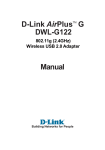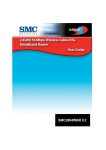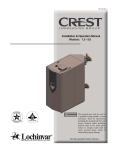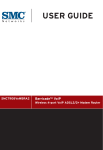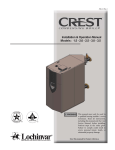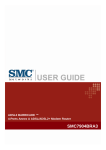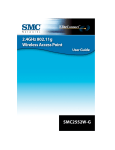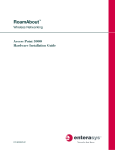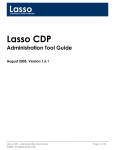Download SMC Networks Barricade SMCWBR14-G User's Manual
Transcript
BarricadeTM g 2.4 GHz 54 Mbps Wireless Cable/DSL Broadband Router From SMC’s Barricade line of Broadband Routers 38 Tesla Irvine, CA 92618 Phone: (949) 679-8000 December 2004 Revision Number: R01 COPYRIGHT Information furnished by SMC Networks, Inc. (SMC) is believed to be accurate and reliable. However, no responsibility is assumed by SMC for its use, nor for any infringements of patents or other rights of third parties which may result from its use. No license is granted by implication or otherwise under any patent or patent rights of SMC. SMC reserves the right to change specifications at any time without notice. Copyright © 2004 by SMC Networks, Inc. 38 Tesla Irvine, CA 92618 All rights reserved. Trademarks: SMC is a registered trademark; and Barricade is a trademark of SMC Networks, Inc. Other product and company names are trademarks or registered trademarks of their respective holders. COMPLIANCES Federal Communication Commission Interference Statement This equipment has been tested and found to comply with the limits for a Class B digital device, pursuant to Part 15 of the FCC Rules. These limits are designed to provide reasonable protection against harmful interference in a residential installation. This equipment generates, uses and can radiate radio frequency energy and, if not installed and used in accordance with the instructions, may cause harmful interference to radio communications. However, there is no guarantee that interference will not occur in a particular installation. If this equipment does cause harmful interference to radio or television reception, which can be determined by turning the equipment off and on, the user is encouraged to try to correct the interference by one of the following measures: • Reorient or relocate the receiving antenna • Increase the separation between the equipment and receiver • Connect the equipment into an outlet on a circuit different from that to which the receiver is connected • Consult the dealer or an experienced radio/TV technician for help FCC Caution: To assure continued compliance, (example - use only shielded interface cables when connecting to computer or peripheral devices) any changes or modifications not expressly approved by the party responsible for compliance could void the user’s authority to operate this equipment. This device complies with Part 15 of the FCC Rules. Operation is subject to the following two conditions: (1) This device may not cause harmful interference, and (2) this device must accept any interference received, including interference that may cause undesired operation. IMPORTANT NOTE: FCC Radiation Exposure Statement This equipment complies with FCC radiation exposure limits set forth for an uncontrolled environment. This equipment should be installed and operated with a minimum distance of 20 centimeters (8 inches) between the radiator and your body. This transmitter must not be co-located or operating in conjunction with any other antenna or transmitter. SMC declared that SMCWBR14-G is limited in CH1~11 from 2400 to 2483.5 MHz by specified firmware controlled in USA. i Compliances Industry Canada - Class B Operation is subject to the following two conditions: 1) this device may not cause interference and 2) this device must accept any interference, including interference that may cause undesired operation of the device This digital apparatus does not exceed the Class B limits for radio noise emissions from digital apparatus as set out in the interference-causing equipment standard entitled “Digital Apparatus,” ICES-003 of the Department of Communications. Cet appareil numérique respecte les limites de bruits radioélectriques applicables aux appareils numériques de Classe B prescrites dans la norme sur le matériel brouilleur: “Appareils Numériques,” NMB-003 édictée par le ministère des Communications. This device has been designed to operate with an antenna having a maximum gain of 1.43 dBi. Antenna having a higher gain is strictly prohibited per regulations of Industry Canada. The required antenna impedance is 50 ohms. To reduce potential radio interference to other users, the antenna type and its gain should be so chosen that the EIRP is not more than required for successful communication. To prevent radio interference to the licensed service, this device is intended to be operated indoors and away from windows to provide maximum shielding. Equipment (or its transmit antenna) that is installed outdoors is subject to licensing. Australia AS/NZS 3548 (1995) - Class B ACN 066096 352010 A.C.N 592 442 SMC contact for products in Australia is: SMC-Australia L9, 123 Epping Rd., North Ryde, NSW Australia Phone: 61-2-88757887 Fax: 61-2-88757777 ii Compliances EC Conformance Declaration SMC contact for these products in Europe is: SMC Networks Europe, Edificio Conata II, Calle Fructuós Gelabert 6-8, 2o, 4a, 08970 - Sant Joan Despí, Barcelona, Spain. Marking by the above symbol indicates compliance with the Essential Requirements of the R&TTE Directive of the European Union (1999/5/EC). This equipment meets the following conformance standards: EN 300 328-1 December 2001 V1.3.1 EN 300 328-2 December 2001 V1.2.1 EN 301 489-1 September 2001 V1.4.1 EN 301 489-17 September 2000 V1.2.1 EN 60950 January 2000 Countries of Operation & Conditions of Use in the European Community This device is intended to be operated in all countries of the European Community. Requirements for indoor vs. outdoor operation, license requirements and allowed channels of operation apply in some countries as described below: Note: The user must use the configuration utility provided with this product to ensure the channels of operation are in conformance with the spectrum usage rules for European Community countries as described below. • This device requires that the user or installer properly enter the current country of operation in the command line interface as described in the user guide, before operating this device. • This device will automatically limit the allowable channels determined by the current country of operation. Incorrectly entering the country of operation may result in illegal operation and may cause harmful interference to other system. The user is obligated to ensure the device is operating according to the channel limitations, indoor/outdoor restrictions and license requirements for each European Community country as described in this document. • This device may be operated indoors or outdoors in all countries of the European Community using the 2.4 GHz band: Channels 1 - 13, except where noted below. - In Italy the end-user must apply for a license from the national spectrum authority to operate this device outdoors. - In Belgium outdoor operation is only permitted using the 2.46 - 2.4835 GHz band: Channel 13. - In France outdoor operation is only permitted using the 2.457 - 2.472 GHz band: Channels 10 - 13. iii Compliances Declaration of Conformity in Languages of the European Community English Hereby, SMC Networks, declares that this Radio LAN device is in compliance with the essential requirements and other relevant provisions of Directive 1999/5/EC. Finnish Valmistaja SMC Networks vakuuttaa täten että Radio LAN device tyyppinen laite on direktiivin 1999/5/EY oleellisten vaatimusten ja sitä koskevien direktiivin muiden ehtojen mukainen. Dutch Hierbij verklaart SMC Networks dat het toestel Radio LAN device in overeenstemming is met de essentiële eisen en de andere relevante bepalingen van richtlijn 1999/5/EG Bij deze SMC Networks dat deze Radio LAN device voldoet aan de essentiële eisen en aan de overige relevante bepalingen van Richtlijn 1999/5/EC. French Par la présente SMC Networks déclare que l'appareil Radio LAN device est conforme aux exigences essentielles et aux autres dispositions pertinentes de la directive 1999/5/CE Swedish Härmed intygar SMC Networks att denna Radio LAN device står I överensstämmelse med de väsentliga egenskapskrav och övriga relevanta bestämmelser som framgår av direktiv 1999/5/ EG. Danish Undertegnede SMC Networks erklærer herved, at følgende udstyr Radio LAN device overholder de væsentlige krav og øvrige relevante krav i direktiv 1999/5/EF German Hiermit erklärt SMC Networks, dass sich dieser/diese/dieses Radio LAN device in Übereinstimmung mit den grundlegenden Anforderungen und den anderen relevanten Vorschriften der Richtlinie 1999/5/EG befindet". (BMWi) Hiermit erklärt SMC Networks die Übereinstimmung des Gerätes Radio LAN device mit den grundlegenden Anforderungen und den anderen relevanten Festlegungen der Richtlinie 1999/5/EG. (Wien) Greek iv Compliances Italian Con la presente SMC Networks dichiara che questo Radio LAN device è conforme ai requisiti essenziali ed alle altre disposizioni pertinenti stabilite dalla direttiva 1999/5/CE. Spanish Por medio de la presente SMC Networks declara que el Radio LAN device cumple con los requisitos esenciales y cualesquiera otras disposiciones aplicables o exigibles de la Directiva 1999/5/ CE Portuguese SMC Networks declara que este Radio LAN device está conforme com os requisitos essenciais e outras disposições da Directiva 1999/5/CE. Safety Compliance Underwriters Laboratories Compliance Statement Important! Before making connections, make sure you have the correct cord set. Check it (read the label on the cable) against the following: Operating Voltage 120 Volts Cord Set Specifications UL Listed/CSA Certified Cord Set Minimum 18 AWG Type SVT or SJT three conductor cord Maximum length of 15 feet Parallel blade, grounding type attachment plug rated 15 A, 125 V 240 Volts (Europe only) Cord Set with H05VV-F cord having three conductors with minimum diameter of 0.75 mm2 IEC-320 receptacle Male plug rated 10 A, 250 V The unit automatically matches the connected input voltage. Therefore, no additional adjustments are necessary when connecting it to any input voltage within the range marked on the rear panel. v Compliances Wichtige Sicherheitshinweise (Germany) 1. Bitte lesen Sie diese Hinweise sorgfältig durch. 2. Heben Sie diese Anleitung für den späteren Gebrauch auf. 3. Vor jedem Reinigen ist das Gerät vom Stromnetz zu trennen. Verwenden Sie keine Flüssigoder Aerosolreiniger. Am besten eignet sich ein angefeuchtetes Tuch zur Reinigung. 4. Die Netzanschlu ßsteckdose soll nahe dem Gerät angebracht und leicht zugänglich sein. 5. Das Gerät ist vor Feuchtigkeit zu schützen. 6. Bei der Aufstellung des Gerätes ist auf sicheren Stand zu achten. Ein Kippen oder Fallen könnte Beschädigungen hervorrufen. 7. Die Belüftungsöffnungen dienen der Luftzirkulation, die das Gerät vor Überhitzung schützt. Sorgen Sie dafür, daß diese Öffnungen nicht abgedeckt werden. 8. Beachten Sie beim Anschluß an das Stromnetz die Anschlußwerte. 9. Verlegen Sie die Netzanschlußleitung so, daß niemand darüber fallen kann. Es sollte auch nichts auf der Leitung abgestellt werden. 10. Alle Hinweise und Warnungen, die sich am Gerät befinden, sind zu beachten. 11. Wird das Gerät über einen längeren Zeitraum nicht benutzt, sollten Sie es vom Stromnetz trennen. Somit wird im Falle einer Überspannung eine Beschädigung vermieden. 12. Durch die Lüftungsöffnungen dürfen niemals Gegenstände oder Flüssigkeiten in das Gerät gelangen. Dies könnte einen Brand bzw. elektrischen Schlag auslösen. 13. Öffnen sie niemals das Gerät. Das Gerät darf aus Gründen der elektrischen Sicherheit nur von authorisiertem Servicepersonal geöffnet werden. 14. Wenn folgende Situationen auftreten ist das Gerät vom Stromnetz zu trennen und von einer qualifizierten Servicestelle zu überprüfen: a. b. c. d. Netzkabel oder Netzstecker sind beschädigt. Flüssigkeit ist in das Gerät eingedrungen. Das Gerät war Feuchtigkeit ausgesetzt. Wenn das Gerät nicht der Bedienungsanleitung entsprechend funktioniert oder Sie mit Hilfe dieser Anleitung keine Verbesserung erzielen. e. Das Gerät ist gefallen und/oder das Gehäuse ist beschädigt. f. Wenn das Gerät deutliche Anzeichen eines Defektes aufweist. 15. Stellen Sie sicher, daß die Stromversorgung dieses Gerätes nach der EN 60950 geprüft ist. Ausgangswerte der Stromversorgung sollten die Werte von AC 7,5-8 V, 50-60 Hz nicht über oder unterschreiten sowie den minimalen Strom von 1 A nicht unterschreiten. Der arbeitsplatzbezogene Schalldruckpegel nach DIN 45 635 Teil 1000 beträgt 70 dB(A) oder weniger. vi TABLE OF CONTENTS About the Wireless Barricade g Router . . . . . . . . 1 LED Indicators . . . . . . . . . . . . . . . . . . . . . . . . . . . . . . . . . . . . . . 1 Features and Benefits . . . . . . . . . . . . . . . . . . . . . . . . . . . . . . . . 2 Installing the Wireless Barricade g Router . . . . . . 3 Package Contents . . . . . . . . . . . . . . . . . . . . . . . . . . . . . . . . . . . 3 Hardware Description . . . . . . . . . . . . . . . . . . . . . . . . . . . . . . . . . 4 System Requirements . . . . . . . . . . . . . . . . . . . . . . . . . . . . . . . . 6 Connect the System . . . . . . . . . . . . . . . . . . . . . . . . . . . . . . . . . . 6 Basic Installation Procedure . . . . . . . . . . . . . . . . . . . . . . . 7 Configuring Client TCP/IP . . . . . . . . . . . . . . . . . . 11 Configuring Your Computer in Windows 2000 . . . . . . . . 12 Configuring Your Computer in Windows XP . . . . . . . . . . 15 Configuring a Macintosh Computer . . . . . . . . . . . . . . . . 16 Manual IP Configuration (for all Windows OS) . . . . . . . . 17 Verifying Your TCP/IP Connection . . . . . . . . . . . . . . . . . 19 Configuring the Wireless Barricade g Router . . 20 Browser Configuration . . . . . . . . . . . . . . . . . . . . . . . . . . . . . . . 20 Disable Proxy Connection . . . . . . . . . . . . . . . . . . . . . . . 21 Navigating the Web Browser Interface . . . . . . . . . . . . . . . . . . . 22 Making Configuration Changes . . . . . . . . . . . . . . . . . . . 23 Setup Wizard . . . . . . . . . . . . . . . . . . . . . . . . . . . . . . . . . . . . . . 24 Time Zone . . . . . . . . . . . . . . . . . . . . . . . . . . . . . . . . . . . . 24 Broadband Type . . . . . . . . . . . . . . . . . . . . . . . . . . . . . . . 25 Advanced Setup . . . . . . . . . . . . . . . . . . . . . . . . . . . . . . . . . . . . 30 System . . . . . . . . . . . . . . . . . . . . . . . . . . . . . . . . . . . . . . 32 WAN . . . . . . . . . . . . . . . . . . . . . . . . . . . . . . . . . . . . . . . . 42 LAN . . . . . . . . . . . . . . . . . . . . . . . . . . . . . . . . . . . . . . . . . 50 Wireless . . . . . . . . . . . . . . . . . . . . . . . . . . . . . . . . . . . . . 51 WDS (Wireless Distribution System) . . . . . . . . . . . . . . . 59 NAT - Network Address Translation . . . . . . . . . . . . . . . . 61 Firewall . . . . . . . . . . . . . . . . . . . . . . . . . . . . . . . . . . . . . . 65 DDNS (Dynamic DNS) Settings . . . . . . . . . . . . . . . . . . . 73 vii TABLE OF CONTENTS UPnP (Universal Plug and Play) Setting . . . . . . . . . . . . 75 Tools . . . . . . . . . . . . . . . . . . . . . . . . . . . . . . . . . . . . . . . 76 Status . . . . . . . . . . . . . . . . . . . . . . . . . . . . . . . . . . . . . . . 79 Troubleshooting . . . . . . . . . . . . . . . . . . . . . . . . . .81 Maximum Distance Table . . . . . . . . . . . . . . . . . . . . . . . . 86 Specifications . . . . . . . . . . . . . . . . . . . . . . . . . . . .87 viii ABOUT THE WIRELESS BARRICADE G ROUTER Congratulations on your purchase of the Wireless Barricade™ g Broadband Router. SMC is proud to provide you with a powerful yet simple communication device for connecting your local area network (LAN) to the Internet. LED Indicators The Wireless Barricade g Router includes status LED indicators, as described in the following figure and table. LED Status Description PWR (Green) On The Wireless Barricade is receiving power. WLAN (Green) On The Wireless LAN is enabled. Flashing The Wireless Barricade is transmitting or receiving traffic via a wireless connection. Green On The indicated Ethernet port has established a valid 100 Mbps network connection. Amber On The indicated Ethernet port has established a valid 10 Mbps network connection. Flashing The indicated Ethernet port is transmitting or receiving traffic. WAN/ LAN1-4 1 About the Wireless Barricade g Router Features and Benefits 2 • Internet connection to DSL or cable modem via a 10/100 Mbps WAN port • Local network connection via 10/100 Mbps Ethernet ports or 54 Mbps wireless interface • IEEE 802.11g Compliant – interoperable with multiple vendors • Advanced security through 64/128-bit WEP encryption, 802.1x, SSID broadcast disabled, and MAC address filtering features to protect your sensitve data and authenticate only authorized users to your network • Provides seamless roaming within 802.11g draft WLAN environment • DHCP for dynamic IP configuration, and DNS for domain name mapping • Firewall with Stateful Packet Inspection, client privileges, hacker prevention, DoS, and NAT • NAT also enables multi-user access with a single-user account, and virtual server functionality such as web, mail, FTP, and Telnet • Virtual Private Network support using PPTP, L2TP, or IPSec pass-through, ISP permitting • Parental controls allow the user to restrict web browsing • Automatic email alerts when the network is being attacked • Easy setup through a web browser on any operating system that supports TCP/IP • Compatible with all popular Internet applications INSTALLING THE WIRELESS BARRICADE G ROUTER Before installing the Wireless Barricade, verify that you have all the items listed under “Package Contents.” If any of the items are missing or damaged, contact your local SMC distributor. Also be sure that you have all the necessary cabling before installing the Wireless Barricade. After installing the Wireless Barricade, refer to the web-based configuration program in “Configuring the Wireless Barricade g Router” on page 20 for information on configuring the Wireless Barricade. Package Contents After unpacking the Wireless Barricade, check the contents of the box to be sure you have received the following components: • Wireless Barricade g Broadband Router • Power adapter • One CAT-5 Ethernet cable • Four rubber feet • Installation CD containing this User Guide and EZ 3-Click Installation Wizard • Quick Installation Guide Immediately inform your dealer in the event of any incorrect, missing or damaged parts. If possible, please retain the carton and original packing materials in case there is a need to return the product. Please register on SMC’s web site at www.smc.com The Wireless Barricade is covered by a limited lifetime warranty. 3 Installing the Wireless Barricade g Router Hardware Description The Wireless Barricade can be connected to the Internet or to a remote site using its WAN port. It can be connected directly to your PC or to a local area network using any of the Fast Ethernet LAN ports. Although access speed to the Internet is determined by your service type and the modem type connected to the Wireless Barricade, data passing between the devices connected to your local area network can run up to 100 Mbps over the Fast Enternet ports. The Wireless Barricade includes an LED display on the front panel for system power and port indications that simplifies installation and network troubleshooting. It also provides four RJ-45 LAN ports and one RJ-45 WAN port on the rear panel. 4 • Four Ethernet ports for connection to a 10BASE-T/ 100BASE-TX Ethernet Local Area Network (LAN). These ports can auto-negotiate the operating speed to 10/100 Mbps, the mode to half/full duplex, and the pin signals to MDI/MDI-X (i.e., allowing these ports to be connected to any network device with straight-through cable). These ports can be connected directly to a PC or to a server equipped with an Ethernet network interface card, or to a networking device such as an Ethernet hub or switch. • One RJ-45 port for connection to a DSL or cable modem (WAN). This port also auto-negotiates operating speed to 10/100 Mbps, the mode to half/full duplex, and the pin signals to MDI/MDI-X. Hardware Description The following figure shows the components of the Wireless Barricade: Figure 1. Front and Rear Panels Item Description LEDs Power, WLAN, WAN and LAN port status indicators. (See “LED Indicators” on page 1.) LAN Ports Fast Ethernet ports (RJ-45). Connect devices (such as a PC, hub or switch) on your local area network to these ports. Reset Button Use this button to reset the power and restore the default factory settings. WAN Port WAN port (RJ-45). Connect your cable modem, DSL modem, or an Ethernet router to this port. Power Inlet Connect the included power adapter to this inlet. Warning: Using the wrong type of power adapter may damage your Wireless Barricade. 5 Installing the Wireless Barricade g Router System Requirements • Internet access from your local telephone company or Internet Service Provider (ISP) using a DSL modem or cable modem. • A PC using a fixed IP address or dynamic IP address assigned via DHCP, as well as a gateway server address and DNS server address from your service provider. • A computer equipped with a 10 Mbps, 100 Mbps, or 10/100 Mbps Fast Ethernet card, or a USB-to-Ethernet converter. • TCP/IP network protocol installed on each PC that needs to access the Internet. • A Java-enabled web browser, such as Microsoft Internet Explorer 5.5 or above, Firefox 1.0 or Mozilla 1.7 installed on one PC at your site for configuring the Wireless Barricade. Connect the System The Wireless Barricade can be positioned at any convenient location in your office or home. No special wiring or cooling requirements are needed. You should, however comply with the following guidelines: • Keep the Wireless Barricade away from any heating devices. • Do not place the Wireless Barricade in a dusty or wet environment. You should also remember to turn off the power, remove the power cord from the outlet, and keep your hands dry when you install the Wireless Barricade. 6 Connect the System Basic Installation Procedure 1. Connect the LAN: Connect the Wireless Barricade to your PC, or to a hub or switch. Run Ethernet cable from one of the LAN ports on the rear of the Wireless Barricade to your computer’s network adapter or to another network device. You may also connect the Wireless Barricade to your PC (using a wireless client adapter) via radio signals. 2. Connect the WAN: Use an Ethernet cable for connecting the Wireless Barricade to a cable/xDSL modem or Ethernet router. 3. Power on: Connect the power adapter to the Wireless Barricade. Internet Internet Access Device Wireless Cable/DSL Broadband Router Notebook with Wireless PC Card SOHO Office or Residence Figure 2. Example Network Configuration 7 Installing the Wireless Barricade g Router Attach to Your Network Using Ethernet Cabling Use twisted-pair cable to connect any of the four LAN ports on the Wireless Barricade to an Ethernet adapter on your PC. Otherwise, you can cascade any of the LAN ports on the Wireless Barricade to an Ethernet hub or switch, and then connect your PC or other network equipment to the hub or switch. When inserting an RJ-45 plug, be sure the tab on the plug clicks into position to ensure that it is properly seated. Warning: Do not plug a phone jack connector into any RJ-45 port. This may damage the Wireless Barricade. Instead, use only twisted-pair cables with RJ-45 connectors that conform with FCC standards. Figure 3. Making a LAN Connection 8 Connect the System Attach to Your Network Using Radio Signals Install a wireless network adapter in each computer that will be connected to the Internet or your local network via radio signals. SMC currently offers several wireless network cards, please visit www.smc.com for more details. Try to place the Wireless Barricade in a position that is located in the center of your wireless network. Normally, the higher you place the antenna, the better the performance. Ensure that the Wireless Barricade’s location provides optimal reception throughout your home or office. A wireless infrastructure can be used for access to a central database, or for connection between mobile workers, as shown in the following figure: Internet Internet Access Device Notebook with Wireless PC Card Adapter Wireless Cable/DSL Broadband Router Wired LAN PC with Wireless PCI Adapter Figure 4. WLAN Connection Example 9 Installing the Wireless Barricade g Router Attach the Wireless Barricade g Router to the Internet If Internet services are provided through an xDSL or cable modem, use unshielded or shielded twisted-pair Ethernet cable CAT 5 with RJ-45 plugs to connect the broadband modem directly to the WAN port on the Wireless Barricade. DSL/Cable Modem ISP (primary) Figure 5. WAN Connection Example 10 CONFIGURING CLIENT TCP/IP To access the Internet through the Wireless Barricade, you must configure the network settings of the computers on your LAN to use the same IP subnet as the Wireless Barricade. The default network settings for the Wireless Barricade are: Gateway IP Address: 192.168.2.1 Subnet Mask: 255.255.255.0 Note: These settings may be changed to suit your network requirements, but you must first configure at least one computer as described in this chapter to access the Wireless Barricade’s web configuration interface. See “Configuring the Wireless Barricade g Router” on page 20 for information on configuring the Wireless Barricade. The IP address of the connected client PC should be 192.168.2.x (where x means 2–254). You can set the IP address for client PCs either by automatically obtaining an IP address from the Wireless Barricade’s DHCP service or by manual configuration. 11 Configuring Client TCP/IP Configuring Your Computer in Windows 2000 1. Access your Network settings by clicking Start, then choose Settings and then select Control Panel. 2. In the Control Panel, locate and double-click the Network and Dial-up Connections icon. 3. Locate and double-click the Local Area Connection icon for the Ethernet adapter that is connected to the Wireless Barricade. When the Status dialog box window opens, click the Properties button. 4. In the Local Area Connection Properties box, verify the box next to Internet Protocol (TCP/IP) is checked. Then highlight the Internet Protocol (TCP/IP), and click the Properties button. 5. Select “Obtain an IP address automatically” to configure your computer for DHCP. Click the OK button to save this change and close the Properties window. 6. Click the OK button again to save these new changes. 7. Reboot your PC. 8. To obtain new network settings see See “Obtain IP Settings from Your Wireless Barricade g Router” on the next page. 12 Configuring Client TCP/IP Obtain IP Settings from Your Wireless Barricade g Router Now that you have configured your computer to connect to the Wireless Barricade, it needs to obtain new network settings. By releasing old IP settings and renewing them with settings from the Wireless Barricade, you will also verify that you have configured your computer correctly. 1. On the Windows desktop, click Start/Programs/Command Prompt. 2. In the Command Prompt window, type IPCONFIG /RELEASE and press the <ENTER> key. 13 Configuring Client TCP/IP 3. Type IPCONFIG /RENEW and press the <ENTER> key. Verify that your IP Address is now 192.168.2.xxx, your Subnet Mask is 255.255.255.0 and your Default Gateway is 192.168.2.1. These values confirm that the Wireless Barricade is functioning. 4. Type EXIT and press <ENTER> to close the Command Prompt window. 14 Configuring Client TCP/IP Configuring Your Computer in Windows XP The following instructions assume you are running Windows XP with the default interface. If you are using the Classic interface (where the icons and menus look like previous Windows versions), please follow the instructions for Windows 2000 outlined above. 1. Access your Network settings by clicking Start, choose Control Panel, select Network and Internet Connections and then click on the Network Connections icon. 2. Locate and double-click the Local Area Connection icon for the Ethernet adapter that is connected to the Wireless Barricade. Next, click the Properties button. 3. In the Local Area Connection Properties box, verify the box next to Internet Protocol (TCP/IP) is checked. Then highlight the Internet Protocol (TCP/IP), and click the Properties button. 4. Select “Obtain an IP address automatically” to configure your computer for DHCP. Click the OK button to save this change and close the Properties window. 5. Click the OK button again to save these new changes. 6. Reboot your PC. 15 Configuring Client TCP/IP Configuring a Macintosh Computer You may find that the instructions here do not exactly match your screen. This is because these steps and screen shots were created using Mac OS 10.2. Mac OS 7.x and above are all very similar, but may not be identical to Mac OS 10.2. 1. Pull down the Apple Menu. Click System Preferences and select Network. 2. Make sure that Built-in Ethernet is selected in the Show field. 3. On the TCP/IP tab, select Using DHCP in the Configure field. 4. Close the TCP/IP dialog box. 16 Configuring Client TCP/IP Manual IP Configuration (for all Windows OS) 1. Check Specify an IP address on the IP Address tab. Enter an IP address based on the default network 192.168.2.x (where x is between 2 and 254), and use 255.255.255.0 for the subnet mask. 2. In the Gateway tab, add the IP address of the Wireless Barricade (default: 192.168.2.1) in the New gateway field and click Add. 17 Configuring Client TCP/IP 3. On the DNS Configuration tab, add the IP address for the Wireless Barricade and click Add. This automatically relays DNS requests to the DNS server(s) provided by your ISP. Otherwise, add specific DNS servers into the DNS Server Search Order field and click Add. 4. After finishing TCP/IP setup, click OK, and then reboot the computer. After that, set up other PCs on the LAN according to the procedures described above. 18 Configuring Client TCP/IP Verifying Your TCP/IP Connection After installing the TCP/IP communication protocols and configuring an IP address in the same network as the Wireless Barricade, use the ping command to check if your computer has successfully connected to the Wireless Barricade. The following example shows how the ping procedure can be executed in an MS-DOS window. First, execute the ping command: ping 192.168.2.1 If a message similar to the following appears: Pinging 192.168.2.1 with 32 bytes of data: Reply from 192.168.2.1: bytes=32 time=2ms TTL=64 a communication link between your computer and the Wireless Barricade has been successfully established. If you get the following message, Pinging 192.168.2.1 with 32 bytes of data: Request timed out. there may be something wrong in your installation procedure. Check the following items in sequence: 1. Is the Ethernet cable correctly connected between the Wireless Barricade and the computer? The LAN LED on the Wireless Barricade and the Link LED of the network card on your computer must be on. 2. Is TCP/IP properly configured on your computer? If the IP address of the Wireless Barricade is 192.168.2.1, the IP address of your PC must be from 192.168.2.2-254 and the default gateway must be 192.168.2.1. If you can successfully ping the Wireless Barricade you are now ready to connect to the Internet! 19 CONFIGURING THE WIRELESS BARRICADE G ROUTER The Wireless Barricade g Router can be configured by Internet Explorer 5.5 or above. Using the web management interface, you can configure the Wireless Barricade and view statistics to monitor network activity. Note: Before you attempt to configure your Wireless Barricade, if you have access to the Internet please visit www.smc.com and download the latest firmware update to ensure your Wireless Barricade is running the latest firmware. Before you attempt to log into the web-based administration, please verify the following. 1. Your browser is configured properly (see below). 2. Disable any firewall or security software that may be running. 3. Confirm that you have a good link LED where your computer is plugged into the Wireless Barricade. If you don’t have a link light, then try another cable until you get a good link. Browser Configuration Confirm your browser is configured for a direct connection to the Internet using the Ethernet cable that is installed in the computer. 20 Browser Configuration Disable Proxy Connection You will also need to verify that the HTTP Proxy feature of your web browser is disabled. This is so that your web browser will be able to view the Wireless Barricade configuration pages. The following steps are for Internet Explorer. Internet Explorer 5.5 or above (For Windows) 1. Open Internet Explorer. Click Tools, and then select Internet Options. 2. In the Internet Options window, click the Connections tab. 3. Click the LAN Settings button. 4. Clear all the check boxes and click OK to save these LAN settings changes. 5. Click OK again to close the Internet Options window. Internet Explorer (For Macintosh) 1. Open Internet Explorer. Click Explorer/Preferences. 2. In the Internet Explorer Preferences window, under Network, select Proxies. 3. Uncheck all check boxes and click OK. 21 Configuring the Wireless Barricade g Router Navigating the Web Browser Interface To access the Wireless Barricade’s management interface, enter the Wireless Barricade IP address in your web browser http://192.168.2.1. Then click LOGIN. (Default password: smcadmin) Note: Login passwords are case sensitive. The home page displays the Setup Wizard and Advanced Setup options. Use the Setup Wizard if you want to quickly set up the Wireless Barricade for use with a cable modem or DSL modem. Advanced setup supports more advanced functions like hacker attack detection, IP and MAC address filtering, intrusion detection, virtual server setup, virtual DMZ hosts, and other advanced functions. 22 Navigating the Web Browser Interface Making Configuration Changes Configurable parameters have a dialog box or a drop-down list. Once a configuration change has been made on a page, be sure to click the APPLY or NEXT button at the bottom of the page to enable the new setting. Note: To ensure proper screen refresh after a command entry, ensure that Internet Explorer 5.5 is configured as follows: Under the menu Tools/Internet Options/ General/Temporary Internet Files/Settings, the setting for “Check for newer versions of stored pages” should be “Every visit to the page.” 23 Configuring the Wireless Barricade g Router Setup Wizard Time Zone Click on the Setup Wizard picture. The first item in the Setup Wizard is Time Zone setup. For accurate timing of client filtering and log events, you need to set the time zone. Select your time zone from the drop-down list. 24 Setup Wizard Broadband Type Select the type of broadband connection you have. For a cable modem connection see the following page. For a Fixed-IP xDSL connection see “Fixed-IP xDSL” on page 26, for a PPPoE xDSL connection, see “PPPoE” on page 27, and for BigPond connection, see “BigPond” on page 29. 25 Configuring the Wireless Barricade g Router Cable Modem Your Internet Service Provider may have given you a host name. If so, enter it into the field. If your ISP used the MAC address of an Ethernet card as an identifier when first setting up your broadband account, only connect the PC with the registered MAC address to the Wireless Barricade and click the Clone MAC Address button. This will replace the current Wireless Barricade MAC address with the already registered Ethernet card MAC address. Click Finish to complete the setup. Fixed-IP xDSL Some xDSL Internet Service Providers may assign a fixed (static) IP address. If you have been provided with this information, choose this option and enter the assigned IP address, subnet mask, gateway IP address, and DNS IP address. Click FINISH to complete the setup. 26 Setup Wizard PPPoE Enter the PPPoE User Name and Password assigned by your Service Provider. The Service Name is normally optional, but may be required by some service providers. Leave the Maximum Transmission Unit (MTU) at the default value (1454) unless you have a particular reason to change it. Enter a Maximum Idle Time (in minutes) to define a maximum period of time for which the Internet connection is maintained during inactivity. If the connection is inactive for longer than the Maximum Idle Time, it will be dropped. (Default: 3 minutes) Connect Mode • Always On Line: If you enable this, idle time is not taken into account. The connection will always be alive. • Manual Connect: When the connection is broken by the idle time, you must press Connect button on the Status page to reconnect (see “Status” on page 79). 27 Configuring the Wireless Barricade g Router • Connect On Demand: When the connection is broken by the idle time, any trigger can make the connection alive. Note: If you are on a leased line or pay-per min. connection, please set your maximum idle time to 3 minutes. This will cause your Internet connection to drop after 3 minutes of idle time so you won’t be charged for extra online time from your ISP. Click FINISH to complete the setup. Point-to-Point Tunneling Protocol (PPTP) Point-to-Point Tunneling Protocol is a common connection method used for xDSL connections in Europe. It can be used to join different physical networks using the Internet as an intermediary. If you have been provided with the information as shown on the screen, enter the PPTP Account name and password, Host Name, Service IP Address, the assigned IP Address, and Subnet Mask. Leave the Maximum Transmission Unit (MTU) at the default value (1460) unless you have a particular reason to change it. 28 Setup Wizard Enter a Maximum Idle Time (in minutes) to define a maximum period of time for which the Internet connection is maintained during inactivity. If the connection is inactive for longer than the Maximum Idle Time, it will be dropped. (Default: 3 minutes) Connect Mode • Always On Line: If you enable this, idle time is not taken into account. The connection will always be alive. • Manual Connect: When the connection is broken by the idle time, you must press Connect button on the Status page to reconnect. • Connect On Demand: When the connection is broken by the idle time, any trigger can make the connection alive. Note: If you are on a leased line or pay-per min. connection, please set your maximum idle time to 3 minutes. This will cause your Internet connection to drop after 3 minutes of idle time so you won’t be charged for extra online time from your ISP. Click FINISH to complete the setup. BigPond If you use the BigPond Internet Service which is available in Australia, enter the the User Name, Password and Authentication Service Name for BigPond authentication. Click FINISH to complete the setup. 29 Configuring the Wireless Barricade g Router Advanced Setup Use the web management interface to define system parameters, manage and control the Wireless Barricade and its ports, or monitor network conditions. The following table outlines the selections available. Menu Description System Sets the local time zone, the password for administrator access, the Internet security of ZoneAlarm Pro (optional), system log server, and the IP address of a PC that will be allowed to manage the Wireless Barricade remotely. WAN Specifies the Internet connection type: • Dynamic IP host configuration and the physical MAC address of each media interface • PPPoE configuration • PPTP configruation • Static IP and ISP gateway address • BigPond (Internet service available in Australia) • Specifies DNS servers to use for domain name resolution. 30 LAN Sets the TCP/IP configuration of the Wireless Barricade’s LAN interface and all DHCP clients. Wireless Configures the radio frequency, SSID, encryption and 802.1x security, and WDS for wireless communications. NAT Shares a single ISP account with multiple users, sets up virtual servers. Firewall Configures a variety of security and specialized functions, including: Access Control, Hacker Prevention, and DMZ. DDNS Dynamic DNS provides users on the Internet with a method to tie their domain name to a computer or server. UPnP With Universal Plug and Play, a device can automatically join a network, obtain an IP address, communicate its capabilities, and learn about the presence and capabilities of other devices. Devices can then directly communicate with each other. This further enables peer-to-peer networking. Advanced Setup Menu Description Tools Contains options to back up and restore the current configuration, restore all configuration settings to the factory defaults, update system firmware, or reset the system. Status Provides WAN connection type and status, firmware and hardware version numbers, system IP settings, as well as DHCP, NAT, and Firewall information. Displays the number of attached clients, the firmware versions, the physical MAC address for each media interface, and the hardware version and serial number. Shows the security and DHCP client log. 31 Configuring the Wireless Barricade g Router System Time Zone Set the time zone and time server for the Wireless Barricade. This information is used for log entries and client access control. • Set your local time zone settings Select your time zone from the drop-down list, and set the start and end dates if your area requires daylight savings. To automatically update the Wireless Barricade’s internal clock by synchronizing with a public time server over the Internet, choose one of the methods below. 32 Advanced Setup • Get date and time from online time servers (Network Time Protocol) Choose the online standard time server for your area from the drop-down menu, or enter the IP address of the time server on your network. • Set date and time using the PC's date and time Click on the radio button for synchronizing the Wireless Barricade’s internal clock with the host PC. • Set date and time manually For manually setting the date and time, configure the date by selecting the options from the drop-down list, and enter the digits for the time. 33 Configuring the Wireless Barricade g Router Password Settings For security you should assign your own password before exposing the Wireless Barricade to the Internet. (Default: smcadmin) Passwords can contain from 3 to 12 alphanumeric characters and are case sensitive. Note: If your password is lost, or you cannot gain access to the user interface, press the Reset button on the rear panel (holding it down for at least five seconds) to restore the factory defaults. Enter a maximum Idle Time Out (in minutes) to define a maximum period of time for which the login session is maintained during inactivity. If the connection is inactive for longer than the maximum idle time, it will perform system logout, and you have to log into the web management system again. (Default: 3 minutes) 34 Advanced Setup Remote Management Remote Management allows a remote PC to configure, manage, and monitor the Wireless Barricade using a standard web browser. Check Enable and set the IP address (range) of the remote host. Click APPLY. (Default: Disable) Note: If you select Any IP Address in the Allow Access to field, any host can manage the Wireless Barricade. 35 Configuring the Wireless Barricade g Router ZoneAlarm Pro® with Web Filtering Setup Your Wireless Barricade now includes a new “Client Enforcement” feature from Zone Labs, Inc. Client Enforcement provides end to end security by ensuring that only protected endpoint PC’s have access to the network. Simply configure your Wireless Barricade to restrict the network access of endpoint PCs that are not in compliance with security requirements. This easy-to-use feature allows you to ensure each of your PCs is safe from Trojan horse and spy-ware style attacks. ZoneAlarm® Pro protects your PC from both known and unknown threats with a combination of: 36 • Stealth firewall that protects each individual computer in your network, and travels with that computer wherever it goes. Mobile endpoint protection is a must for traveling laptops; • Program Control to manage which applications are connecting to the Internet, blocking spy-ware and other malicious software from sending your personal information out from your computer; • MailSafe to identify and quarantine potentially harmful email attachments (coming in and going out), to prevent email viruses, worms and Trojans disguised as attachments from getting onto to your machine and mass-email worms from sending viruses out to the people in your address book; and Advanced Setup • Privacy protection to keep your identity and web-surfing habits confidential with features such as cookie control, 3rd-party spy protection and cache cleaner to protect your privacy while you surf, and ad-blocking and parental control keep your surfing safe and distraction-free. By refusing Internet or WAN access to any workstation not running ZoneAlarm Pro, security of your network is greatly increased. You can easily make exceptions for individual workstations at your discretion. When an Internet request is rejected, the user will be routed to http://smc.zonelabs.com where (s)he will be given the option to purchase ZoneAlarm Pro or upgrade to the proper version required by the policy. The option does not significantly affect system performance, so we advise enabling it to protect your network users. Select Enable and click the APPLY button. Note: When you select the Enable radio button in the Enable or Disable ZoneAlarm® Pro Security field, be sure to press the APPLY button. 37 Configuring the Wireless Barricade g Router • License Key The License Key field is optional. To input your ZoneAlarm Pro (ZAP) License Number, type in or paste the license number you received at the time of purchase. Note: Only licenses for ZoneAlarm Pro with Web Filtering 4.x and higher, purchased through http://smc.zonelabs.com, can be inserted directly into this field. Click the Buy ZoneAlarm Pro Now! to purchase a license.You will be directed to the http://smc.zonelabs.com web site where you can complete your product purchase. • Version Requirement for Internet Access The Version Requirement for the Internet Access field is an optional setting. This field gives you even tighter control over the enforcement of ZoneAlarm Pro software. In addition to requiring ZoneAlarm Pro software for network access, you can also specify what version of ZoneAlarm Pro users need to run to 38 Advanced Setup ensure that users always run the most up-to-date version of the software. • ZoneAlarm Pro Security Level The overhead for communication between the router and Zone Alarm Pro with Web Filtering on your PCs is very minimal. The communication packets are small and infrequent. However, if you do feel it is causing a delay on your network, you have some control over the frequency the packets are sent to and from ZoneAlarm Pro and the Wireless Barricade. On the ZoneAlarm Pro (ZAP) Settings Panel on the Wireless Barricade, the ZAP Security Level option tells the Wireless Barricade and ZoneAlarm Pro how often they should communicate. This communication tells the Wireless Barricade that ZoneAlarm Pro is still running on the PC. If you set this option to High Security (Check Frequently), the exchange will occur at smaller intervals. Though we feel this should not impact your network performance, you do have the option to select Medium Security (Check Less Frequently) to increase the interval. • Exempt LAN Clients Option This option allows you to Enable or Disable the creation of a range of IP addresses for PCs which are non–Windows or require exemption from this enforcement policy. Note: This option is set as Disabled by default. When you select the Enabled radio button in the Exempt LAN Client Option field, be sure to press the APPLY button. 39 Configuring the Wireless Barricade g Router • From IP Address Input the last three digits of the first IP Address from the range of IP addresses that you would like to exempt from this policy enforcement. Note: • The default IP address of the Wireless Barricade is 192.168.2.1. The IP address that can be assigned to a PC workstation on the network is 192.168.2.x (where x means 2–254). See “Configuring Client TCP/IP” on page 11. To IP Address Input the last three digits of the last IP Address from the range of IP addresses that you would like to exempt from this policy enforcement. Note: 40 You also need to make sure that Exempt LAN Client Option is set to Enable. Be sure to press the APPLY button after completing the entry. Advanced Setup Syslog Server The Syslog Server downloads the Wireless Barricade’s log file to the server with the IP address specified on this screen. Syslog servers offer the possibility to capture the live logs of the router on a PC. There are many shareware syslogs servers available on the web. (Default: Disabled) 41 Configuring the Wireless Barricade g Router WAN Specify the WAN connection type provided by your Internet Service Provider, then click More Configuration to enter detailed configuration parameters for the selected connection type. 42 Advanced Setup Dynamic IP The Host Name is optional, but may be required by some ISPs. The default MAC address is set to the WAN’s physical interface on the Wireless Barricade. Use this address when registering for Internet service, and do not change it unless required by your ISP. If your ISP used the MAC address of an Ethernet card as an identifier when first setting up your broadband account, only connect the PC with the registered MAC address to the Wireless Barricade and click the Clone MAC Address button. This will replace the current Wireless Barricade MAC address with the already registered Ethernet card MAC address. If you are unsure of which PC was originally set up by the broadband technician, call your ISP and request that they register a new MAC address for your account. Register the default MAC address of the Wireless Barricade. 43 Configuring the Wireless Barricade g Router Point-to-Point Over Ethernet (PPPoE) Enter the PPPoE User Name and Password assigned by your Service Provider. The Service Name is normally optional, but may be required by some service providers. The MTU (Maximum Transmission Unit) governs the maximum size of the data packets. Leave this on the default value (1454) unless you have a particular reason to change it. Enter a Maximum Idle Time (in minutes) to define a maximum period of time for which the Internet connection is maintained during inactivity. If the connection is inactive for longer than the Maximum Idle Time, it will be dropped. (Default: 3 minutes) Connect Mode 44 • Always On Line: If you enable this, idle time is not taken into account. The connection will always be alive. • Manual Connect: When the connection is broken by the idle time, you must press Connect button on the Status page to reconnect. Advanced Setup • Connect On Demand: When the connection is broken by the idle time, any trigger can make the connection alive. Note: If you are on a leased line or pay-per min. connection, please set your maximum idle time to 3 minutes. This will cause your Internet connection to drop after 3 minutes of idle time so you won’t be charged for extra online time from your ISP. Point-to-Point Tunneling Protocol (PPTP) Point-to-Point Tunneling Protocol (PPTP) can be used to join different physical networks using the Internet as an intermediary. Using the above screen allows client PCs to establish a normal PPTP session and provides hassle-free configuration of the PPTP client on each client PC. Enter the PPTP Account, Password, Host Name, and then Service IP Address (usually supplied by your ISP), the assigned IP address, and subnet mask. 45 Configuring the Wireless Barricade g Router Leave the Maximum Transmission Unit (MTU) at the default value (1460) unless you have a particular reason to change it. Enter a maximum Idle Time Out (in minutes) to define a maximum period of time for which the PPTP connection is maintained during inactivity. If the connection is inactive for longer than the Maximum Idle Time, it will be dropped. (Default: 3 minutes) Connect Mode • Always On Line: If you enable this, idle time is not taken into account. The connection will always be alive. • Manual Connect: When the connection is broken by the idle time, you must press Connect button on the Status page to reconnect. • Connect On Demand: When the connection is broken by the idle time, any trigger can make the connection alive. Note: 46 If you are on a leased line or pay-per min. connection, please set your maximum idle time to 3 minutes. This will cause your Internet connection to drop after 3 minutes of idle time so you won’t be charged for extra online time from your ISP. Advanced Setup Static IP If your Internet Service Provider has assigned a fixed IP address, enter the assigned address and subnet mask for the Wireless Barricade, then enter the gateway address of your ISP. You may need a fixed address if you want to provide Internet services, such as a web server or FTP server. 47 Configuring the Wireless Barricade g Router BigPond BigPond is a service provider in Australia that uses a heartbeat system to maintain the Internet connection. Configure the built-in client with your user name, password and service name to get on line. 48 Advanced Setup DNS Domain Name Servers map numerical IP addresses to the equivalent domain name (e.g., www.smc.com). Your ISP should provide the IP address of one or more domain name servers. Enter those addresses in this screen. 49 Configuring the Wireless Barricade g Router LAN • LAN IP – Use the LAN menu to configure the LAN IP address for the Wireless Barricade and to enable the DHCP server for dynamic client address allocation. • Set a period for the lease time if required. For home networks this may be set to Forever, which means there is no time limit on the IP address lease. • IP Address Pool – A dynamic IP address range may be specified (192.168.2.2–254). IP addresses running from 192.168.2.100–199 are the default values. Once the IP addresses, e.g. 192.168.2.100–199, have been assigned, these IP addresses will be part of the dynamic IP address pool. IP addresses from 192.168.2.2–99, and 192.168.2.200–254 will be available as static IP addresses. Remember not to include the address of the Wireless Barricade in the client address pool. Also remember to configure your client PCs for dynamic IP address allocation. 50 Advanced Setup Wireless The Wireless Barricade can easily be configured as a Wireless Access Point, so the wireless clients can connect directly to it to form a wireless network. The wireless PCs must be set to infrastructure mode to communicate with the Access Point. Channel and SSID To create a wireless network, the Wireless Barricade and wireless PCs must have the same Service Set ID (SSID), encryption settings and channel number. The wireless settings for the Wireless Barricade are described below: SSID: The Service Set ID (SSID) is the name given to your wireless LAN. Only PCs with the same SSID as the Wireless Barricade can connect to the wireless LAN. (Default is SMC) Note: The SSID is case sensitive and can consist of up to 32 alphanumeric characters. 51 Configuring the Wireless Barricade g Router SSID Broadcast: By default, the Wireless Barricade will transmit the SSID in the wireless beacons as part of the normal wireless protocol. To increase your wireless security the SSID Broadcast can be disabled. (Default: Enable) Wireless Mode: Set the communication mode for the Wireless Barricade. (Default: Long Range Mixed (11b+11g)) The Long Range Mixed (11b+11g) is an enhanced operation mode. It provides a long range wireless connectivity of 328 feet associated with the IEEE 802.11b standards by offering faster speeds and longer distances from a wireless access point to a wireless PC card. g Nitro: The g Nitro implemented by Intersil’s Prism Nitro technology dramatically enhances your wireless network speeds. It provides up to 30% more throughput in an 11g only environment, and improves network throughput by 3 times in mixed mode. (Default: Enable) Transmission Rate: As the wireless client moves further away from the Wireless Barricade, then the wireless data rate reduces. The transmit data rate from the Wireless Barricade can be fixed or set to Auto. (Default: Auto) Wireless Channel: The wireless channel is set in the Wireless Barricade. The wireless PCs will automatically scan the wireless channels to detect and use the same channel as the Wireless Barricade. (Default: 6) Note: 52 The available channel settings are limited by local regulations. Advanced Setup Security If you are transmitting sensitive data across wireless channels, you should enable Wi-Fi Protected Access (WPA) or Wired Equivalent Privacy (WEP) encryption. Encryption security requires you to use the same protocol set (WPA or WEP) and encryption/decryption keys for the Wireless Barricade and all of your wireless clients. For a more secure network, the Wireless Barricade can implement one of the following security mechanisms: • Wi-Fi Protected Access (WPA) page 55 • Wired Equivalent Privacy (WEP) page 57 53 Configuring the Wireless Barricade g Router The security mechanisms that may be employed depend on the level of security required, the network and management resources available, and the software support provided on wireless clients. A summary of wireless security considerations is listed in the following table. Security Client Mechanism Support Implementation Considerations WEP Built-in support on all 802.11b and 802.11g devices • Provides only weak security • Requires manual key management WPA mode Requires WPA-enabled • Provides good security in small system and network networks card driver • Requires configured RADIUS server, or manual management of pre-shared (native support provided key in Windows XP) 802.1x mode • Provides robust security in WPA-only mode (i.e., WPA clients only) Requires WPA-enabled • Requires configured RADIUS server system and network card driver • 802.1x Extensible Authentication Protocol (EAP) type may require (native support provided management of digital certificates for in Windows XP) clients and server 54 Advanced Setup WPA Encryption Type WPA is a stronger wireless security solution than WEP. It uses a combination of authentication and broadcast/session keys. • Pre-Shared Key/Passphrase If there is no authentication server on your SOHO network, you can issue the Pre-Shared Key to the clients that connect to the Wireless Barricade. Be sure to use the same key for the Wireless Barricade and the connected clients. Notes: 1. Manual Pre-Shared Key supports up to 64-Hex characters. 2. Type 8~63 Hex characters for the Pre-Shared Passphrase. 55 Configuring the Wireless Barricade g Router 3. Do not use a key that is long and complex for your clients to type accurately, as you might forget it. 4. A Hex (hexadecimal) digit is a number or letter in the range 0-9 or A-F. • 802.1X Mode The Wireless Barricade allows you to use 802.1x authentication for an enterprise network environment with a RADIUS server installed. In 802.1x mode, access will be checked against the authentication database stored on the Wireless Barricade. You must specify the authentication period, and the corresponding parameters in the RADIUS Server Parameters field for the remote authentication protocol. 56 Advanced Setup WEP Encryption Type You can choose between standard 40/64-bit or the more robust 128-bit encryption. To manually configure the keys, select the WEP Encryption Type option from the drop down menu. For 40/64-bit encryption enter 5 hexadecimal pairs for each key. For 128-bit encryption enter 13 hexadecimal pairs for each key. 57 Configuring the Wireless Barricade g Router To generate the keys automatically, select the Passphrase option from the drop down menu. For 40/64-bit encryption, 4 keys will be generated. For 128-bit encryption, 1 key is generated and repeated for the 4 keys. The Active Transmit Key determines which key is used to encrypt the transmit data. SMC recommend that you change the Active Transmit key at regular intervals to maintain the security of your wireless network. Note: Active ASCII Keys must be exactly 5 characters for 40/ 64-bit WEP. Active ASCII Keys must be exactly 13 characters for 128-bit WEP. If you use encryption, configure the same keys used for the Wireless Barricade on each of your wireless clients. Note that Wired Equivalent Privacy (WEP) protects data transmitted between wireless nodes, but does not protect any transmissions over your wired network or over the Internet. 58 Advanced Setup WDS (Wireless Distribution System) When repeater is enabled, this Wireless Barricade g Router functions as a wireless repeater and is able to wirelessly communicate with other access points or wireless gateways via WDS (Wireless Distribution System) links. You can specify up to six WDS links, where each link is defined by the MAC addresses of the other repeater capable access point or wireless gateway. Note that for each repeater access point or wireless gateway specified on this page, you must also configure that access point or wireless gateway to have a WDS link back to the Wireless Barricade g Router. (Default: Disable) Notes: 1. Be sure that all access points with the same WDS links should use the same operation “Mode” (802.11b or 802.11g) and radio “Channel” number. 2. Choosing “Auto” of the wireless channel is not suggested for using WDS. (See “Channel and SSID” on page 51.) 59 Configuring the Wireless Barricade g Router To establish a WDS connection between access points, follow the steps below. 1. Check Enable Repeater radio button. 2. Enter the MAC address of the access point to which you want to connect. 3. Click Wireless/Channel and SSID of the navigation menu for configuring the operation mode (11b or 11g) and radio channel on the Wireless Barricade g Router. 60 Advanced Setup NAT - Network Address Translation From this section you can configure the Address Mapping, Virtual Server, and Special Application features that provide control over the TCP/UDP port openings in the router’s firewall. This section can be used to support several Internet based applications such as web, email, FTP, and Telnet. Address Mapping Allows one or more public IP addresses to be shared by multiple internal users. Enter the Public IP address you wish to share into the Global IP field. Enter a range of internal IPs that will share the global IP. 61 Configuring the Wireless Barricade g Router Virtual Server If you configure the Wireless Barricade as a virtual server, remote users accessing services such as web or FTP at your local site via public IP addresses can be automatically redirected to local servers configured with private IP addresses. In other words, depending on the requested service (TCP/UDP port number), the Wireless Barricade redirects the external service request to the appropriate server (located at another internal IP address). For example, if you set Type/Public Port to TCP/80 (HTTP or web) and the Private IP/Port to 192.168.2.2/80, then all HTTP requests from outside users will be transferred to 192.168.2.2 on port 80. Therefore, by just entering the IP address provided by the ISP, Internet users can access the service they need at the local address to which you redirect them. The more common TCP service ports include: HTTP: 80, FTP: 21, Telnet: 23, and POP3: 110 62 Advanced Setup Special Applications Some applications, such as Internet gaming, videoconferencing, Internet telephony and others, require multiple connections. These applications cannot work with Network Address Translation (NAT) enabled. If you need to run applications that require multiple connections, use the following screen to specify the additional public ports to be opened for each application. Specify the public port number normally associated with an application in the Trigger Port field. Set the protocol type to TCP or UDP, then enter the ports that the application requires. 63 Configuring the Wireless Barricade g Router Popular applications requiring multiple ports are listed in the Popular Applications field. From the drop-down list, choose the application and then choose a row number to copy this data into. Note: Choosing a row that already contains data will overwrite the current settings. Example: ID Trigger Port Trigger Type Public Port Public Type Comment 1 6112 UDP 6112 UDP Battle.net 2 28800 TCP 2300-2400, TCP MSN Game Zone 47624 For a full list of ports and the services that run on them, see www.iana.org/assignments/port-numbers. 64 Advanced Setup Firewall The Wireless Barricade firewall can provide access control of connected client PCs, block common hacker attacks, including IP Spoofing, Land Attack, Ping of Death, IP with zero length, Smurf Attack, UDP port loopback, Snork Attack, TCP null scan, and TCP SYN flooding. The firewall does not significantly affect system performance, so we advise enabling it to protect your network users. Access Control Using this option allows you to specify different privileges based on IP address for the client PCs. 65 Configuring the Wireless Barricade g Router Note: 66 Click on Add PC and define the appropriate settings for client PC services (as shown in the following screen). Advanced Setup MAC Filtering Table The MAC Filtering feature of the Wireless Barricade allows you to control access to your network for up to 32 clients based on the MAC (Media Access Control) address of the client machine. This ID is unique to each network adapter. If the MAC address is listed in the table, that client machine will have access to the network. 67 Configuring the Wireless Barricade g Router URL Blocking To configure the URL Blocking feature, use the table below to specify the web sites (e.g. www.somesite.com) and/or keywords you want to filter on your network. To complete this configuration, you will need to create or modify an access rule in “Access Control” on page 65. To modify an existing rule, click the Edit option next to the rule you want to modify. To create a new rule, click on the Add PC option. From the Access Control Add PC section check the option for “WWW with URL Blocking” in the Client PC Service table to filter out the web sites and keywords specified below. Use the above screen to block access to web sites or to web URLs containing the keywords specified in the keyword table. 68 Advanced Setup Schedule Rule The Schedule Rule feature allows you to configure specific rules based on time and date. These rules can then be used to configure more specific access control. 69 Configuring the Wireless Barricade g Router Enable schedule-based Internet access control. 1. Click Add Schedule Rule. 2. Define the settings for the schedule rule (as shown on the following screen). 3. Click OK and then click the APPLY button to save your settings. 70 Advanced Setup Intrusion Detection • SPI and Anti-DoS (Denial-of-Service) firewall protection (Default: Enable) – The Intrusion Detection Feature limits access for incoming traffic at the WAN port. When the SPI (Stateful Packet Inspection) feature is turned on, all incoming packets will be inspected. • Discard Ping from WAN (Default: Enable) – Prevents the router from responding to any PING request on the WAN port. • E-mail Alert Configuration – Enter your email address. Specify your SMTP and POP3 servers, user name, and password. 71 Configuring the Wireless Barricade g Router DMZ (Demilitarized Zone) If you have a client PC that cannot run an Internet application properly from behind the firewall, then you can open the client up to unrestricted two-way Internet access. Enter the IP address of a DMZ host to this screen. Adding a client to the DMZ may expose your local network to a variety of security risks, so only use this option as a last resort. 72 Advanced Setup DDNS (Dynamic DNS) Settings 73 Configuring the Wireless Barricade g Router Dynamic DNS (DDNS) provides users on the Internet with a method to tie their domain name to the router or server. DDNS allows your domain name to follow your IP address automatically by having your DNS records changed when your IP address changes. (Default: Disabled) The DDNS service dynamically updates DNS information to a static hostname, provided by the DDNS service provider, as clients’ IP addresses change. Note: Please visit the web sites of the DDNS providers for details. DDNS Service Provider Web Site DynDNS.org http://www.dyndns.org No-IP.com http://www.no-ip.com TZO.com http://www.tzo.com DYNDNS.COM http://www.dyndns.com For using DDNS, click on the enable radio button, select the DDNS Service type, and then enter the user name, pass key (password), host name or server IP, and email address. Mail Exchanger (MX) and Backup MX provides you with flexible email configurations. It allows you to control the delivery of your mail for a specified domain or a subdomain. The Wildcard keeps your hostname pointing to your IP address. The TZO.com powered DNS allows you to host your own web site, email server, FTP site, and more at your own location even if you have a dynamic IP address. The Server Configuration section automatically opens the port options checked in the Virtual Server section. 74 Advanced Setup UPnP (Universal Plug and Play) Setting Enable UPnP by checking ON in the screen above. UPnP allows the device to automatically: • dynamically join local network • obtain an IP address • convey its capabilities and learn about the presence and capabilities of other devices. • dynamically open ports for UPnP aware software, such as MSN messenger advanced features (voice, remote control). 75 Configuring the Wireless Barricade g Router Tools Use the Tools menu to back up the current configuration, restore a previously saved configuration, restore factory settings, update firmware, and reset the Wireless Barricade. Tools - Configuration Tools • Backup Router Settings – Saves the Wireless Barricade’s configuration to a file. • Restore Router Settings – Restores settings from a saved backup configuration file. 1. Select the saved file by clicking on the browse button 2. Click the “Restore from config file.” • 76 Restore to factory defaults – Restores the Wireless Barricade settings back to the factory defaults. Advanced Setup Tools - Firmware Upgrade Use this screen to update the firmware or user interface to the latest versions. Download the upgrade file from the SMC web site (www.smc.com) and save it to your hard drive. In the Firmware File field, click Browse to look for the downloaded file. Click APPLY. Check the Status page Information section to confirm that the upgrade process was successful. 77 Configuring the Wireless Barricade g Router Tools - Reset Click APPLY to reset the Wireless Barricade. The reset will be complete when the power LED stops blinking. Note: 78 If you use the Reset button on the rear panel, the Wireless Barricade performs a power reset. If the button is depressed for over five seconds, all the LEDs will illuminate and the factory settings will be restored. Advanced Setup Status The Status screen displays WAN/LAN connection status, firmware, and hardware version numbers, illegal attempts to access your network, as well as information on DHCP clients connected to your network. The following items are included on this screen: Section Description INTERNET Displays WAN connection type and status. Release (Disconnect) Click on this button to disconnect from the WAN. Renew (Connect) Click on this button to establish a connection to the WAN. GATEWAY Displays system IP settings, as well as DHCP and Firewall status. INFORMATION Displays the number of attached clients, the firmware versions, the physical MAC address for each media interface, as well as the hardware version and serial number. 79 Configuring the Wireless Barricade g Router Section 80 Description Security Log Displays illegal attempts to access your network. Save Click on this button to save the security log file. Clear Click on this button to delete the access log. Refresh Click on this button to refresh the screen. DHCP Client Log Displays information on all DHCP clients on your network. TROUBLESHOOTING The information outlined in this section describes some useful steps for getting your computer and the Wireless Barricade online. A. Verify your connection to the Wireless Barricade. If you are unable to access the Wireless Barricade’s web-based administration pages, then you may not be properly connected or configured. The screen shots in this section were taken on a Windows 2000 machine, but the same steps will apply to Windows 98/Me/XP. To determine your TCP/IP configuration status please follow the steps below: 1. Click Start then choose Run. 2. Type cmd or command to open a DOS prompt. 3. In the DOS window, type ipconfig and verify the information that is displayed. 4. If your computer is set up for DHCP, then your TCP/IP configuration should be similar to the information displayed: • IP Address: 192.168.2.x (x is number between 100 and 199 by default.) • Subnet: 255.255.255.0 • Gateway: 192.168.2.1 81 Troubleshooting If you have an IP address that starts with 169.254.xxx.xxx then see the next section. If you have another IP address configured, then see section C. B. I am getting an IP Address that starts with 169.254.xxx.xxx If you are getting this IP address, then you need to check that you are properly connected to the Wireless Barricade. Confirm that you have a good link light on the Wireless Barricade for the port to which this computer is connected. If not, please try another cable. If you have a good link light, please open up a DOS window as described in the previous section and type ipconfig/renew. If you are still unable to get an IP address from the Wireless Barricade, please try rebooting your PC. C. I have another IP Address displayed. If you have another IP address listed, then the PC may not be configured for a DHCP connection. Please refer to “Configuring Client TCP/IP” on page 11 for information. Once you have confirmed that your computer is configured for DHCP, then please follow the steps below. 1. Open a DOS window as described above. 82 Troubleshooting 2. Type ipconfig/release. 3. Then type ipconfig/renew. D. The 10/100 LED does not light after a connection is made. 1. Check that the host computer and the Wireless Barricade are both powered on. 2. Be sure the network cable is connected to both devices. 3. Verify that Category 5 cable is used if you are operating at 100 Mbps, and that the length of any cable does not exceed 100 m (328 ft). 83 Troubleshooting 4. Check the network card connections. 5. The 10BASE-T/100BASE-TX port, network card, or cable may be defective. E. If wireless clients cannot access the network, check the following: 1. Be sure the Wireless Barricade and the wireless clients are configured with the same Service Set ID (SSID). 2. If authentication or encryption are enabled, ensure that the wireless clients are properly configured with the appropriate authentication or encryption keys. 3. If authentication is being performed through a RADIUS server, ensure that the clients are properly configured on the RADIUS server. 4. If authentication is being performed through IEEE 802.1x, be sure the wireless users have installed and properly configured 802.1x client software. 5. If MAC address filtering is enabled, be sure the client’s address is included in the local filtering database. 6. If the wireless clients are roaming between Wireless Barricade, make sure that all the access points and wireless devices in the Extended Service Set (ESS) are configured to the same SSID, and authentication method. 84 Troubleshooting F. If you forgot or lost the password: Set the Wireless Barricade to its default configuration by pressing the reset button on the back panel for 10 seconds or more. There is no password by default. G. If all other recovery measures fail, and the Wireless Barricade is still not functioning properly, take any of these steps: 1. Reset the Wireless Barricade’s hardware using the web interface, or through a power reset. 2. Reset the Wireless Barricade to its default configuration by pressing the reset button on the back panel for 10 seconds or more. Then click LOGIN to access the management interface. 85 Troubleshooting Maximum Distance Table Important Notice Maximum distances posted below are actual tested distance thresholds. However, there are many variables such as barrier composition and construction and local environmental interference that may impact your actual distances and cause you to experience distance thresholds far lower than those posted below. 802.11b Wireless Distance Table Speed and Distance Ranges Environment 11 Mbps 5.5 Mbps 2 Mbps 1 Mbps Outdoors1 300 m 984 ft 465 m 1525 ft 500 m 1639 ft 515 m 1689 ft Indoors2 60 m 197 ft 70 m 230 ft 83 m 272 ft 85 m 279 ft 802.11g Wireless Distance Table Speed and Distance Ranges Environment 54 48 36 24 18 12 11 9 6 5 2 1 Mbps Mbps Mbps Mbps Mbps Mbps Mbps Mbps Mbps Mbps Mbps Mbps Outdoors1 82 m 100 m 300 m 330 m 350 m 450 m 470 m 485 m 495 m 510 m 520 m 525 m 269 ft 328 ft 984 ft 1082 ft 1148 ft 1475 ft 1541 ft 1590 ft 1623 ft 1672 ft 1705 ft 1722 ft Indoors2 20 m 25 m 35 m 43 m 50 m 57 m 66 m 71 m 80 m 85 m 90 m 93 m 66 ft 82 ft 115 ft 141 ft 164 ft 187 ft 216 ft 233 ft 262 ft 279 ft 295 ft 305 ft Notes: 1. Outdoor Environment: A line-of-sight environment with no interference or obstruction between the Wireless Barricade and clients. 2. Indoor Environment: A typical office or home environment with floor to ceiling obstructions between the Wireless Barricade and clients. 86 SPECIFICATIONS Below is an outline of the technical specifications for the SMCWBR14-G. Standards IEEE 802.3 10BASE-T Ethernet IEEE 802.3u 100BASE-TX FastEthernet IEEE 802.11b IEEE 802.11g WAN Interface 10BASE-T/100BASE-TX LAN Interfaces 10BASE-T/100BASE-TX 4 RJ-45 ports: LAN data transfer rate is up to 10/20 Mbps (10BASE-T half/full duplex) or 100/200 Mbps (100BASE-TX half/full duplex) Data Rates 1/2/5.5/6/9/11/12/18/24/36/48/54 Mbps Supports “Nitro Lite” turbo mode (data rate upto 140Mbps) Frequency Band IEEE 802.11b/g Radio: 2.4 GHz USA FCC 2412~2462MHz (Ch1~Ch11) Canada - IC2412~2462MHz (Ch1~Ch11) Europe - ETSI 2412~2472MHz (Ch1~Ch13) Japan STD-T66/STD-332412~2484MHz (Ch1~Ch14) Modulation Type OFDM, CCK 87 Specifications Operating Channels IEEE 802.11b/g compliant 11 channels (US, Canada) 13 channels (ETSI) 14 channels (Japan) Antenna Antenna Type 1 Dipole antenna with RP-SMA connector Antenna Gain 1.43 dBi Sensitivity Modulation Rate 88 Modulation Rate Receive Sensitivity Typical (dBm) 802.11b - 1Mbps -90 802.11b - 2Mbps -88 802.11b - 5.5Mbps -85 802.11b- 11Mbps -82 802.11g - 6Mbps -88 802.11g - 9Mbps -87 802.11g - 12Mbps -84 802.11g - 18Mbps -82 802.11g - 24Mbps -79 802.11g - 36Mbps -75 802.11g - 48Mbps -68 802.11g - 54Mbps -68 Specifications RF Output Power Modulation Rate Output Power (dBm) 802.11b - 1Mbps 16 802.11b - 2Mbps 16 802.11b - 5.5Mbps 16 802.11b- 11Mbps 16 802.11g - 6Mbps 15 802.11g - 9Mbps 15 802.11g - 12Mbps 15 802.11g - 18Mbps 15 802.11g - 24Mbps 15 802.11g - 36Mbps 15 802.11g - 48Mbps 12 802.11g - 54Mbps 12 Management Browser-based management Both DHCP Server and Client provided Advanced Features Dynamic IP Address Configuration – DHCP, DNS Wireless Security – 64/128-bit WEP/TKIP/AES-CCM/AES-OCB/ 802.1x, WDS, SSID broadcast disabled, MAC address filtering 11g Nitro mode Firewall – Access control, hacker prevention, logging Virtual Server via NAT & NAPT Virtual Private Network – PPTP, L2TP, IPSec pass-through Intrusion Detection, email Alerts, Parental Control 89 Specifications Indicator Panel Power, WLAN, WAN (Link, Activity), LAN (Link/Activity, Speed - 10/100 Mbps) Dimensions 155 x 130 x 26 mm (6.10 x 5.12 x 1.02 in.) Weight 410 g (14.46 oz) Input Power 9 VDC, 1 A DVE US: DV-91A EU: DV-91AUP Power Consumption 5 Watts max. @ 100-240 VAC Internet Standards RFC 826 ARP, RFC 791 IP, RFC 792 ICMP, RFC 768 UDP, RFC 793 TCP, RFC 854-859 TELNET, RFC 1321 MD5, RFC 1497 BOOTP Extension, RFC 1570 PPP LCP Extension, RFC 1631 NAT, RFC1661 PPP, RFC 1700 Assigned Numbers, RFC 1866 HTML, RFC 1945 HTTP, RFC 1994 CHAP, RFC 2131 DHCP, RFC 2637 PPTP Temperature Operating 0 to 40 °C (32 to 104 °F) Storage -40 to 70 °C (-40 to 158 °F) Humidity 5% to 95% (non-condensing) 90 Specifications Compliances CE Mark Emissions FCC Class B VCCI Class B Industry Canada Class B EN55022 (CISPR 22) Class B C-Tick - AS/NZS 3548 (1995) Class B Immunity EN 61000-3-2/3 EN 61000-4-2/3/4/5/6/8/11 DGT LP0002: 2004 Safety CSA/NRTL (UL1950, CSA 22.2.950) GS (EN60950) CB (IEC60950) 91 Specifications 92











































































































